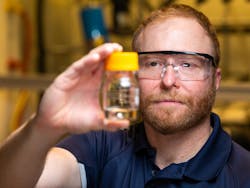Carbon Capture 'Breakthrough' Claims Economic Viability
A new process to capture CO2 and convert it to methanol, developed by researchers at the Pacific Northwest National Laboratory (PNNL), and described in the Advanced Materials Journal last year, now claims to be the least costly system to date.
In a recent paper by several of the same researchers, published in the Journal of Cleaner Production, the cost to capture the CO2 from a pulverized coal power plant exhaust flue is estimated to be as low as $38.80 per metric ton. According to a 2021 U.S. Dept. of Energy analysis, the cost of carbon capture using then-available commercial technology was approximately $58.30 per metric ton. At that time, PNNL believed the cost could be reduced to $47.10 per metric ton.
The new process uses a water-lean solvent (approximately 2% water vs. 70% water in some processes) known as EEMPA (N-(2-EthoxyEthyl)-3-MorpholinoPropan-1-Amino). The lower water content can result in a 36% energy savings compared with aqueous amines. For those of us (like me) who have forgotten most of our chemistry studies, an amine is a nitrogen-containing organic compound that is derived from ammonia.
One of the major points made in the 2018 United Nations Intergovernmental Panel on Climate Change (IPCC) “Special Report on Global Warming of 1.5°C” was that merely reducing greenhouse gas (GHG) emissions would not limit global warming to the 1.5-degree threshold considered critical. So the special report suggested that negative-emissions technologies (NET) must also be adopted. But unlike PNNL’s carbon capture technology, NETs remove and sequester CO2 from the atmosphere using technologies like Direct Air Capture. Unfortunately, these technologies are energy-intensive and expensive ($200–1,000/metric ton) and cannot be relied upon to completely replace the capture of GHG emissions from fossil fuel processes such as those used in power plants, cement production, and steel industries.
In addition to a lower energy penalty, PNNL’s EEMPA process also produces methanol at a cost competitive with that made industrially using a CO2/CO and H2 mixture with a copper-based catalyst at high temperature and pressure.
Methanol is used as a feedstock for hundreds of everyday products, including plastics, paints, car parts and construction materials, and as a clean energy source. In PNNL’s analysis, the minimum selling price of methanol was evaluated by means of a simple annualized cost approach used by the Process Economics Program (PEP) Yearbook, the world’s largest online chemical process economics database. The results suggest that the minimum selling price of methanol using current state-of-technology is approximately $1,460/metric ton. Renewable methanol using CO2 from carbon capture at a cost of $50/metric ton for the CO2 was nearly 10% higher, at $1,600/metric ton.
Capturing CO2 using PNNL’s EEMPA process costs $38.80-45.30/metric ton, on average 16% less than the $50 baseline in the PEP analysis. So the renewable methanol cost would achieve parity with that of the industrial methanol, making it an economically viable investment for power plant owners and operators.
This is very good news for carbon capture.
##########
A regular contributor to HPAC Engineering and a member of its editorial advisory board, the author is a principal at Sustainable Performance Solutions LLC, a south Florida-based engineering firm focusing on energy and sustainability. He can be reached at [email protected].
About the Author
Larry Clark
A member of HPAC Engineering’s Editorial Advisory Board, Lawrence (Larry) Clark, QCxP, GGP, LEED AP+, is principal of Sustainable Performance Solutions LLC, a South Florida-based engineering firm focused on energy and sustainability consulting. He has more than two dozen published articles on HVAC- and energy-related topics to his credit and frequently lectures on green-building best practices, central-energy-plant optimization, and demand-controlled ventilation.
